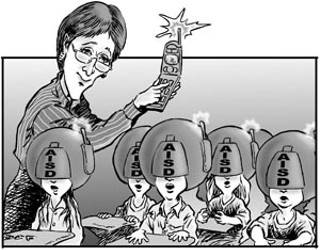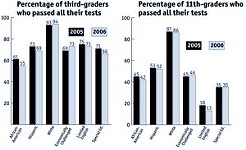High Tech Schools: The Future, or the Latest Fad?
Will new technology funding go to build skills or just buy stuff?
By Rachel Proctor May, Fri., Dec. 31, 2004

The University of Texas Elementary School in East Austin is what those in the field of educational technology like to call "fully integrated." Students learn reading, for example, through online sites with names like Imagination Station or through a library of LeapFrog storybooks. Students place them on electronic LeapPads and read along with recordings of sentences, words, or phonetic elements which the students control by touching their Leap pens to different hot spots on the book's pages. Meanwhile, their teachers use the LeapTrack assessment system to identify individual weaknesses and specific LeapFrog storybooks designed to remedy them.
The idea, principal Ramona Treviño says, is to teach technology not as a separate class but to incorporate it into all areas of learning. She proudly points out that Microsoft has called the UT Elementary a "school of the future," and believes that the sooner that future comes to all schools, the better. "I think it's a tragedy the way technology is being presented in the schools," she said. "The digital divide is very real, especially in East Austin, as technology gets put on the back burner because of the focus on the TAKS tests."
That future may well be on its way. The House Committee on Public Education recently held a public hearing on educational technology in conjunction with an expo for technology vendors. Chairman Kent Grusendorf, R-Arlington, eagerly pressed witnesses to weigh in on the recommendation of an eLearning task force Grusendorf convened last year, which suggested phasing in an increased technology allotment of $300 per pupil per year. The current allotment is about $30 per student.
While the report isn't itself a legislative proposal, the question of how much to spend on educational technology in a tight-budget era will doubtless be on the legislative agenda come spring. But while no one disagrees that today's students need technology skills, the experiences of UT Elementary, and other Austin-area schools, suggest that meeting schools' technology needs is not so simple as buying the right program and flipping a switch. "I hope the purpose is not that we have 100 kids in a gymnasium and you stand there and push a button and assume the kids are going to learn from the machines," said Rep. Scott Hochberg, D-Houston, a member of the Public Education committee.
At UT Elementary, instructional technology specialist and second-grade teacher Jessica Gribble raves about the way the LeapPads, Palm Pilots, and other tools help her do her job. Technology, she says, can be used for three basic areas. First, it can be used to teach the technology itself, such as a class in word processing. Second, it helps teachers track students' progress and preparedness for statewide TAKS tests.
But the most interesting, and widely debated, area is the extent to which technology can help teach other skills such as reading. Gribble says the programs UT Elementary is using make a world of difference. "The thing I've seen technology be the most important for is bringing individualized instruction to the kids," she said – LeapFrog's plethora of storybooks, for example, allows her 20 second-graders to simultaneously work on 20 different language elements, depending on their needs.
But while it's clear that programs do a good job teaching skills that can be drilled and whose mastery can be measured – either you know how to subtract or you don't – the value of digital content for a topic like English or social studies is harder to determine. This is something that just came up in Round Rock ISD, as the board declined to include funds to give all high schoolers laptops in its bond proposal, in part because trustees were unconvinced that incorporating digital content into all subject areas would improve learning enough to justify the cost. This concern is not limited to RRISD; the Texas Education Agency is currently running a pilot program comparing student performance at 30 "highly integrated" middle schools with 30 nonintegrated ones.
However, Ed Zointz, RRISD's director of information services, argues that the pilot project may not measure technology's true impact. "When you talk about the skills that come from integration of technology, those are not things that are measured on achievement tests," he said. "You get students who are actively involved in learning, who are learning how to work together or stand in front of a group to do a [PowerPoint] presentation. These are 21st-century skills, critical skills students need to have when they join the work force."
Nevertheless, UT Elementary's Gribble says that in the rush to see all that technology can do, it's important to also remember what it can't do. "It's that human interaction, the things a good teacher does, that a computer can't do," she said. "It doesn't build relations. If a student doesn't understand something, a computer can't say it another way." She expresses concern about a rhetoric that emerged in the technology hearing – that if you just find the right digital content and push "play," teachers become "co-learners," or even students, of their students.
It's dangerous rhetoric – Treviño calls it "a joke" – when many schools say that in the rush to buy electronic resources, nonelectronic ones like professional training or technical support are being left behind. "We've got an impossible job trying to maintain what we've got," said Jeff Meyer, AISD's director of instructional technology. "We certainly need computers and 'stuff' but we need people to help run it. That's always the hardest thing to do. And traditionally, you can't use state monies to pay for people."
The solution to that dilemma – whether technology allotments will go toward empowering teachers with skills or be specifically earmarked for buying more stuff – will demonstrate the state's ultimate motives. Is the rush to spend more educational dollars on technology, at a time when districts are already squeezed, really about providing the very best education for Texas students, or is it about providing the very best boost to vendors' bottom lines?
Got something to say on the subject? Send a letter to the editor.








